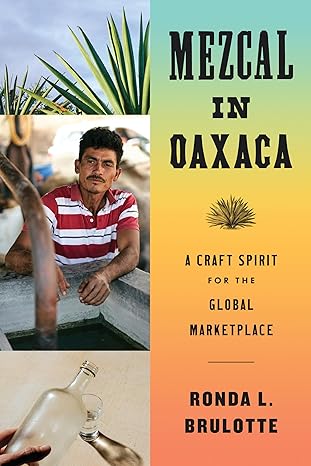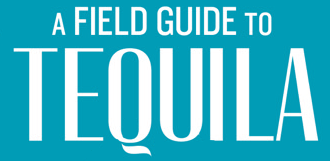Book Review: Mezcal in Oaxaca: A Craft Spirit for the Global Marketplace, by Ronda Brulotte (University of Texas Press, 2025)

In Mezcal in Oaxaca: A Craft Spirit for the Global Marketplace, anthropologist Ronda Brulotte invites us to step back and take in a broad and critical view of mezcal: a view that most definitely includes us as mezcal consumers.
Brulotte has decades of research and life experience in Oaxaca, and her previous academic work focused on folk art and the nature of authenticity. From this perspective, she views the recent “boom” in mezcal as a proxy for wider changes in Oaxaca over the past three decades, and an indicator of cultural shifts in the United States.
The book’s first two chapters take on mezcal’s rapid rise from maligned obscurity to hip ingredient in metropolitan cocktail bars. While many readers will be familiar with the broad contours of that story, Brulotte’s lucid writing evokes particularly vivid memories of the days–not that long ago, really–when being served a mezcalito in Oaxaca City meant you were either at a locals’ party or a cantina of ill repute.
Brulotte places the beginning of the mezcal boom just before 2010. Among the many who lived that moment, few have likely wondered why mezcal exploded at that particular time. To answer the question “why then?”, Brulotte adroitly weaves her analysis of mezcal into her broader anthropological work on the concept of craft. She connects the early 21st-century interest in craft (e.g., cocktails, farm-to-table, Etsy) to similar historical moments after the Industrial Revolution and emerging from 1960s counterculture, when social change and rising alienation spurred consumers to seek “authentic” handmade goods. Brulotte argues that in the case of mezcal, it was the upheaval of the 2008 financial crisis and resulting dissatisfaction with late-stage capitalism that facilitated a turn toward Oaxaca (and mezcal) as part of a search for meaningful consumption. Mezcal was introduced to non-Oaxacan drinkers through commodification: it became just another good with a sales price. This process inevitably created winners and losers, and Brulotte suggests that most of the winners have not been rural Oaxacans, despite how justifiably celebrated the exceptions may be.
Chapters on mezcal tasting and tourism, respectively, make up the middle portion of the book. These may be challenging for mezcal aficionados and industry folks to read, as we become the focus of Brulotte’s critical eye. She describes how taste and distinction are constructed through “mezcal talk.” In such discourse, tasters simultaneously demonstrate their purported expertise and place mezcal at the same level as fine wine, through rarified tasting notes that can leave outsiders baffled. Brulotte’s rather bemused analysis of mezcal tasting will likely strike a bit close to the bone for some, and her deconstruction at times seems to imply that there is no objective basis for aromas and flavors, and that judgements of quality may as well be arbitrary. This perspective may discourage some readers from grappling with the otherwise muscular arguments here, which would be a shame.
Reading Brulotte as entirely unsympathetic to mezcal consumers would also be a mistake. In fact, she sees aficionados as driven less by gustatory appetites than by hope. Hope, embodied in mezcal, that “humans can shape their own destiny” and hope that marginalized mezcaleros can “transform the way they are viewed in the world.” The trouble with this, for Brulotte, is that we get carried away, self-focused, and end up in the “fraught activity” of creating expertise, in part, by reinforcing the very types of social hierarchies that we claim to oppose.
Brulotte also sees hierarchies emerge in mezcal tourism, when outsiders project their own ideals and desires onto mezcaleros rather than seeing what’s actually in front of them. Again, her observations will likely challenge many readers’ self-congratulatory notions about their role as mezcal tourists. Brulotte asks us to consider our impact on the people and places we visit, as we expect and demand that they be what we imagine them to be. She argues that “we should not assume that there was simply a place (Oaxaca) and a product (mezcal), and then people started to show up,” but that “a place like Oaxaca becomes a centrifuge for the skilled tourist consumer” who “inadvertently created the brand they wanted to cultivate.” This is all facilitated by “fictive kinship” between producers and aficionados, and marketing based on “narratives of discovery, clandestine operations, or artistic projects” spun by charismatic gringo brand owners. This process begins with mezcal industry visits, followed by groups of aficionados, and results in mass tourism engaging in the “folkloric gentrification” of Oaxaca.
Arguably, Brulotte’s most provocative and subtle arguments comprise the final two chapters, on gender and the economic impact of mezcal in Oaxaca, respectively.
While the “bro culture” often apparent in the mezcal scene may appear at odds with narratives of women’s empowerment, Brulotte shows that they both form part of the same patriarchal fabric in mezcal marketing. First, such narratives often focus on relatively privileged women like urban, non-Oaxacan brand owners. Furthermore, she argues that the singling out of exceptional maestras mezcaleras (like Reyna Sánchez) isn’t necessarily any kind of feminist achievement. Such exceptionalism tends to obscure the everyday contributions that myriad women make to mezcal: in direct production, managing household finances, and other gendered household activities. The continued invisibility of this labor creates “an ideology of novelty and scarcity” around femininity that adds value to mezcal-as-commodity without that value necessarily being enjoyed by the “exceptional” female producers themselves. While these remarkable maestras enjoy a certain fame, it’s arguable whether that status has translated into real economic improvement in their lives, as they primarily sell bulk mezcal to be bottled by others.
Throughout the book, there is an overarching critique of the individualistic tendency to glorify the singular maestro or maestra mezcalero while downplaying or erasing the contributions of families, communities, and wage workers. By assigning value to the individual “authorship” of a maestro while ignoring other forms of labor, Northern consumers project what we want to see (unalienated labor, authenticity, rural harmony) and blind ourselves to the bigger picture, which, in addition to many lovely things, also features continued exploitation, poverty, and marginalization. In reality, Brulotte suggests, mezcal is less “special” and distinct from other commodities than it appears in marketing narratives and the consumer imagination.
Mezcal is often touted as a way out of rural poverty and a brake on involuntary migration. Brulotte argues that the situation is not so simple. First, for every success story like the González brothers of Tosba Mezcal (profiled in the book), there are likely ten times as many cases of failure, or of mezcal simply offering temporary wage work en route to a different destination in life. More significantly, Brulotte convincingly illustrates that the experience of international migration itself is often an essential element in a successful mezcalero’s biography, giving producers like Tosba a leg up in the market by facilitating a “cosmopolitan subjectivity”: the ability to “be at home” in divergent worlds, from rural Oaxaca, to fancy US cocktail bars and corporate board rooms.
Brulotte’s social and cultural analysis is broad and deep, but there was one apparent gap that left me curious for more. The book only cursorily mentions less prestigious mezcal brands like Monte Albán, Benevá, and Oro de Oaxaca. These brands predate the mezcal boom, remain stigmatized by aficionados, and their owners occupy a place in the Oaxacan class structure that Brulotte doesn’t touch upon. It would be fascinating to see her analysis applied to the political economy of these brands, as well as to how they may be used as foils in the construction of distinction she describes early in the book.
Anyone with a serious interest in mezcal should read Mezcal in Oaxaca. The writing is clear and amiable, even when elucidating arguments based on nuanced academic social theory. The discomfort that Brulotte’s critical view may evoke in the reader makes it all the more crucial. In pushing mezcal consumers to broaden their perspectives and critically assess their own interests and roles, Ronda Brulotte provides an invaluable service to mezcal and the communities that produce it.
Purchase Mezcal in Oaxaca from the The University of Texas Press.
